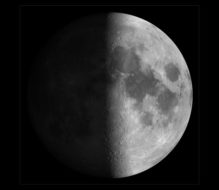International Observe the Moon Night 2019 – Sky & Telescope
Whatever else you’re doing, take some time out to observe the Moon this coming Saturday. And show it to your friends and neighbors, too.
This coming Saturday, October 5th, is both International Astronomy Day and International Observe the Moon Night. That makes sense in many ways. The whole point of International Astronomy Day is that it’s a time when people with telescopes should take them out to their local street corner, town center, or other gathering point, and encourage any and all passersby to take a look at the glories of the universe. But most places where people congregate have streetlights, which make it almost impossible to see galaxies, and difficult to see even the brightest star clusters.
Not so with the Moon. The Moon is dazzlingly bright to the unaided eye and overwhelming through a telescope; it shrugs off even the worst light pollution. Its the easiest celestial body to find and one of the most rewarding to observe. Even the smallest and cheapest telescopes and binoculars show anywhere from dozens to thousands of craters and other lunar features, many of them in great detail. The average person on the street is disappointed by the views of many deep-sky objects, but I have never once met anyone who was disappointed by his or her first telescopic view of the Moon.

The Moon on the evening of October 5, 2019, as seen from the time zones of the Americas. Virtual Moon Atlas 6.0
It’s true that the Moon is currently unfashionable in the amateur-astronomy community, because its glow hides faint stars and deep-sky objects at otherwise dark sites. But observing the Moon itself is endlessly fascinating. That’s particularly true when it’s close to half-lit, because that’s when the terminator — the line between lit and unlit — sweeps fastest across the face of the Moon. If you watch carefully for a while, you should see points of light suddenly kindle on the dark side of the terminator, and then grow, and perhaps eventually even merge into the fully-lit part. What you have seen is sunlight hitting first the top of a mountain, then sweeping down its slopes, and finally illuminating the plain upon which the mountain rests.
As a huge side-bonus, Saturn and the Moon are in conjunction this evening. They’re closest around 8 p.m. Universal Time, which is great for observers in the Old World but not so good for the Americas. In fact, the Moon actually occults (hides) Saturn as seen from parts of Africa. Enterprising observers in the Americas might want to catch the Moon-Saturn pair when they’re closest, in the afternoon. This is a rare opportunity to find Saturn easily in broad daylight, with the Moon as a marker. In the early evening Americans will still see the Moon within two to four degrees of Saturn, fitting easily together in a binocular field of view. This is a perfect chance to show the general public the sky’s two most spectacular objects side by side.
So even if you customarily avoid the Moon, make a point of going out to view it on Saturday. And encourage all your friends, relatives, and neighbors to take a look too. What could be a more fitting way to celebrate the 50th anniversary of the first human footsteps on the Moon?





